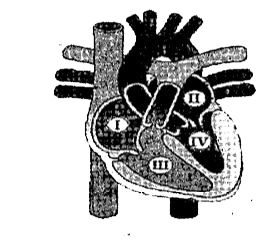Fishes have venous heart. The heart receives deoxygenated from all over the body except
Fins
pectoral fins
Gills
pelvic fins
The correct Answer is:C
To solve the question, "Fishes have venous heart. The heart receives deoxygenated blood from all over the body except," we will analyze the options provided and determine which one does not contribute deoxygenated blood to the fish's heart.
1. Understand the Function of the Fish Heart:
- Fishes have a venous heart, which means it primarily receives deoxygenated blood from the body. This blood is then sent to the gills for oxygenation.
2. Analyze the Options:
- Option 1: Fins - Fins are used for swimming and do not play a role in blood circulation. Therefore, they do not contribute deoxygenated blood to the heart.
- Option 2: Pectoral Fins - Similar to fins, pectoral fins are used for gliding and maneuvering in water. They do not provide deoxygenated blood to the heart.
- Option 3: Gills - Gills are responsible for oxygenating deoxygenated blood. Blood that reaches the gills is deoxygenated, but it is not sent to the heart; instead, it is oxygenated in the gills.
- Option 4: Pelvic Fins - Pelvic fins also help with balance and movement in water. They do not contribute deoxygenated blood to the heart.
3. Determine the Correct Answer:
- The question asks for the source of blood that does not contribute deoxygenated blood to the heart. Since gills oxygenate the blood and do not send deoxygenated blood to the heart, the correct answer is Gills.
Final Answer:
The heart of fishes receives deoxygenated blood from all over the body except Gills.
---
- Fishes have a venous heart, which means it primarily receives deoxygenated blood from the body. This blood is then sent to the gills for oxygenation.
- Option 1: Fins - Fins are used for swimming and do not play a role in blood circulation. Therefore, they do not contribute deoxygenated blood to the heart.
- Option 2: Pectoral Fins - Similar to fins, pectoral fins are used for gliding and maneuvering in water. They do not provide deoxygenated blood to the heart.
- Option 3: Gills - Gills are responsible for oxygenating deoxygenated blood. Blood that reaches the gills is deoxygenated, but it is not sent to the heart; instead, it is oxygenated in the gills.
- Option 4: Pelvic Fins - Pelvic fins also help with balance and movement in water. They do not contribute deoxygenated blood to the heart.
- The question asks for the source of blood that does not contribute deoxygenated blood to the heart. Since gills oxygenate the blood and do not send deoxygenated blood to the heart, the correct answer is Gills.
The heart of fishes receives deoxygenated blood from all over the body except Gills.
Similar Questions
Which chamber of the heart receives impure blood from the body ?
View SolutionDraw the diagram of sectional view of human heart and on it name and label the following parts:
(a) The chamber of the heart that pumps out deoxygenated blood.
(b) The blood vessel that carries away oxygenated blood from the heart.
(c ) The blood vessel that receives deoxygenated blood from the lower part of our body.View Solution
Knowledge Check
- Question 1 - Select One
Fishes have venous heart. The heart receives deoxygen-ated blood from all over the body except
AFinsBHindlimbsCGillsDForelimbs - Question 2 - Select One
The heart receives blood from the sinuses through
AHaemocoelBAlary musclesCOstiaDAorta - Question 3 - Select One
Fishes have a ______chambered heart.
ASingleBThreeCFourDTwo

Deoxygenated blood flows from the body into theView SolutionWhich artery carnes deoxygenated blood from the heart?
View SolutionWhich of the following parts of heart first receives deoxygenated blood ?
View SolutionDeoxygenated blood from wall of heart is carried by
View SolutionWhich of the following statement (s) is (are) true about heart?
(i) Left atrium receives oxygenated blood from different parts of body while right atrium receives deoxygenated blood from lungs
(ii) Left ventricle pumps oxygenated blood to different body parts while right ventricle pumps deoxygenated blood to lungs
(iii) Left atrium transfers oxygenated blood to right ventricle which sends it to different body parts
(iv) Right atrium receives deoxygenated blood from different part of the body while left ventricle pumps oxygenated blood to different parts of the bodyView Solution

